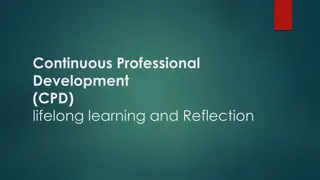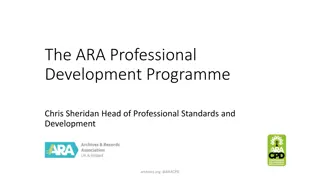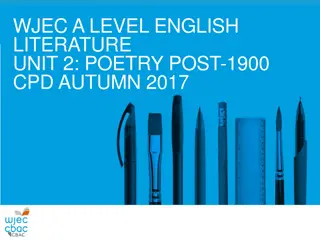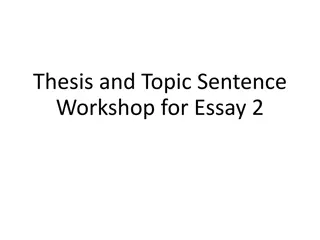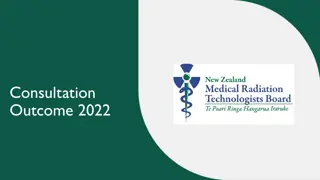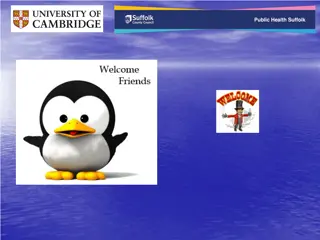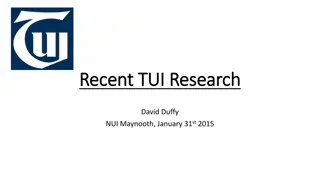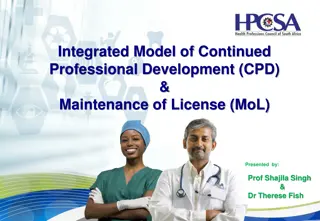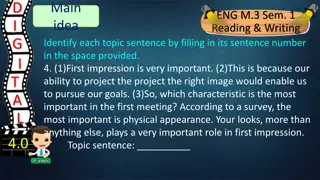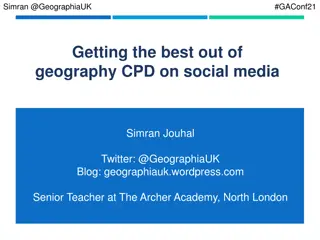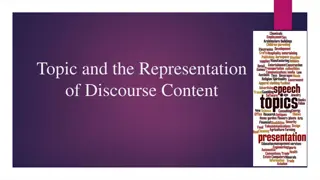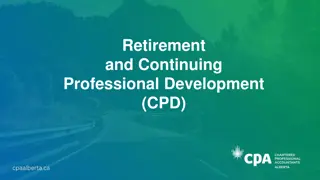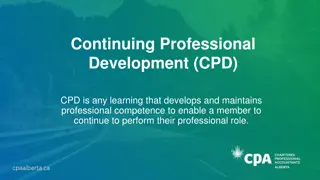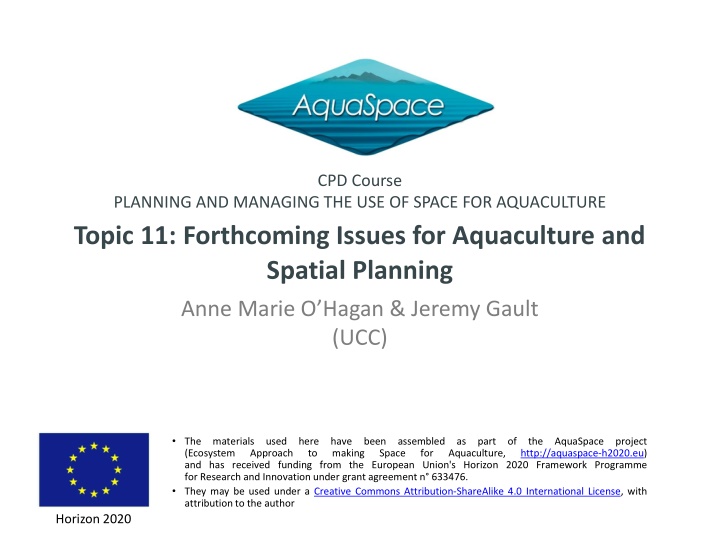
Challenges and Future Prospects for Aquaculture Spatial Planning
Explore the forthcoming issues in aquaculture spatial planning, including changing environmental legislation, competitive challenges, and governance approaches. Learn about the identified challenges by the EC for marine finfish, shellfish, freshwater aquaculture, and other marine aquaculture sectors. Discover the evolving landscape of aquaculture policy in the EU and the role of new governance models in addressing sustainability concerns.
Download Presentation

Please find below an Image/Link to download the presentation.
The content on the website is provided AS IS for your information and personal use only. It may not be sold, licensed, or shared on other websites without obtaining consent from the author. If you encounter any issues during the download, it is possible that the publisher has removed the file from their server.
You are allowed to download the files provided on this website for personal or commercial use, subject to the condition that they are used lawfully. All files are the property of their respective owners.
The content on the website is provided AS IS for your information and personal use only. It may not be sold, licensed, or shared on other websites without obtaining consent from the author.
E N D
Presentation Transcript
CPD Course PLANNING AND MANAGING THE USE OF SPACE FOR AQUACULTURE Topic 11: Forthcoming Issues for Aquaculture and Spatial Planning Anne Marie O Hagan & Jeremy Gault (UCC) The (Ecosystem and has received funding from the European Union's Horizon 2020 Framework Programme for Research and Innovationunder grant agreementn 633476. They may be used under a Creative Commons Attribution-ShareAlike 4.0 International License, with attributionto the author materials used here to have making been assembled Space as part of the AquaSpace project Approach for Aquaculture, http://aquaspace-h2020.eu) Horizon 2020
Aquaculture and future EU policy? Aquaculture is one of the identified Blue Growth sectors Most recent reform of CFP gives aquaculture more prominence likely to continue in future Reform packages? All EU Member States now have Multi-annual National Aquaculture Plans These include Member States' objectives until 2020 and Measures to be used to achieve those objectives Changing environmental legislation Impact Assessment Conservation New management approaches (MSP, adaptive management?)
Challenges identified by the EC (2016) Marine Finfish: Lack of available space in inshore sheltered areas Competitiveness of products against produce from outside the EU Administrative procedures and environmental legislation (monitoring) Shellfish: Lack of space in inshore areas Need to extend shelf-life (linked to marketing) Changing environmental conditions / Disease control / Hazards
Challenges identified by the EC (2016) Freshwater aquaculture: Small scale operators have limited access to finance to expand operations High input costs (e.g. labour, land) put the sector at a disadvantage Fragmented structure of the sector (supply v. demand issues) Lack of space due to competition with other users Other Marine Aquaculture: Competition with other users
Other considerations New governance approaches: Economic-based management Society more concerned about sustainable and safe food production Rise in Corporate Social Responsibility (CSR) Certification schemes Community-based management Role of Social Licence to Operate Leading to Hybrid governance Involves governmental actors, non-state actors such as civil society organizations and NGOs, fishermen's cooperatives, and private businesses in the decision-making process.
The future of Aquaculture: What is needed for the future is an approach which makes use of the experience available, adds to the existing know-how through continued research efforts, elaborates and refines guidelines, and creates appropriate frameworks for further development. . . Aquaculture production is in great demand, but it must not be achieved without due regard to safeguarding our basis of survival. (Bilio (1993) p.v. quoted in Brug re et al., 2018)
Ecosystem Approach to Aquaculture to support MSP How to support (selected) countries in managing aquaculture intensification by using the 6 steps of the EAA to support MSP? Opportunity and risk assessment EAA has been defined by FAO (2010) as a strategy for the integration of the activity within the wider ecosystem such that it promotes sustainable development, equity and resilience of interlinked social- ecological systems . Scoping Carrying capacity analysis Monitoring of the plan Allocation of user/area access Develop management plans for the area FAO and World Bank, 2015
Review of Implementation of EAA to date Different levels of uptake in different locations General lack of reference to the EAA in aquaculture policy and governance (e.g. Hishamunda et al. 2014; O Hagan et al., 2017) illustrates the difficulty in linking the EAA to governance matters Only one of the Multi-annual National Aquaculture Plans in AquaSpace partner countries refer to the EAA (O Hagan et al., 2017) Has highlighted the usefulness of more participatory approaches in delivering sustainability Efforts to mainstream the EAA into policy have been sectoral Could be compared and contrasted with Integrated Coastal Management Are there lessons here for MSP? Differences in how EAA is implemented: is it a conceptual guide or an actual process?
Good practice examples of EAA implementation Chile - Fisheries and Aquaculture Law is being reviewed to include the EAA and an associated new policy will guide aquaculture development for the next 20 years Nicaragua participatory engagement process with stakeholders from multiple institutions at various administrative levels prepared EAA management plans for aquaculture development in sensitive zones Scotland implementation of Farm Management Areas, developed by industry, and Disease Management Areas, created by government and industry Turkey aquaculture zoning for fish cages, moving production further offshore to avoid conflicts with other coastal uses See case study examples in Aguilar-Manjarrez, et al., 2017 and also on the AquaSpace project website
Future needs? [1] Need for aquaculture policy, strategies and development plans at national level Multi-annual National Aquaculture Plans are one step but need to be supported by Action Plans and resources for implementation Must be embedded within strategic marine policies such as MSP Knowledge of existing aquaculture activity and its value chains Spatial planning tools that can take account of changes which will occur at local and global levels and their impacts on ecosystems and resource use How to deal with trade-offs? Availability of credit and appropriate financing instruments Transparent and facilitative consenting systems Good coordination and stakeholder engagement mechanisms, particularly cross-sectoral Social licence to operate
Future needs? [2] Risk-based framework Ability to adapt to changing circumstances (e.g. climate, new policies etc.) Increases resilience to external factors Integrated assessment process that promotes co-existence with other uses and sectoral objectives Management system that prevents and controls diseases and the introduction of invasive species Technical capacity Risk assessment Carrying capacity studies Disease modelling New tools such as GIS-based tools, visualisation and remote sensing?
References Aguilar-Manjarrez, J., Soto, D. & Brummett, R. 2017. Aquaculture zoning, site selection and area management under the ecosystem approach to aquaculture. Full document. Report ACS113536. Rome, FAO, and World Bank Group, Washington, DC. 395 pp. Brug re, c., Aguilar-Manjarrez, J., Beveridge, M.C.M. and Soto, D. 2018. The ecosystem approach to aquaculture 10 years on a critical review and consideration of its future role in blue growth. Reviews in Aquaculture (2018) 0, 1 22. DOI: 10.1111/raq.12242 European Commission. 2016. Summary of the 27 Multiannual National Aquaculture Plans. Prepared by FAME SU under contract to DG MARE. https://ec.europa.eu/fisheries/cfp/aquaculture/multiannual-national-plans FAO / World Bank. 2015. Aquaculture zoning, site selection and area management under the ecosystem approach to aquaculture. Policy brief. Rome, Italy. Hishamunda, N., Ridler, and Martone, E. 2014. Policy and governance in aquaculture: lessons learned and way forward. FAO Fisheries and Aquaculture Technical Paper No. 577. FAO, Rome. O Hagan, A.M., Corner, R.A., Aguilar-Manjarrez, J. Gault, J., Ferreira, R.G., Ferreira, J.G., O Higgins, T., Soto, D., Massa, F., Bacher, K., Chapela, R. and D. Fezzardi. 2017. Regional review of Policy-Management Issues in Marine and Freshwater Aquaculture. Report produced as part of the Horizon 2020 AquaSpace project. 170pp.
For more information about the AquaSpace CPD Course and spatial planning toolbox, visit our website: www.aquaspace-h2020.eu The materials used here have been assembled as part of the AquaSpace project (Ecosystem Approach to making Space for Aquaculture, http://aquaspace-h2020.eu) and has received funding from the European Union's Horizon 2020 Framework Programme for Research and Innovation under grant agreement n 633476. Horizon 2020

